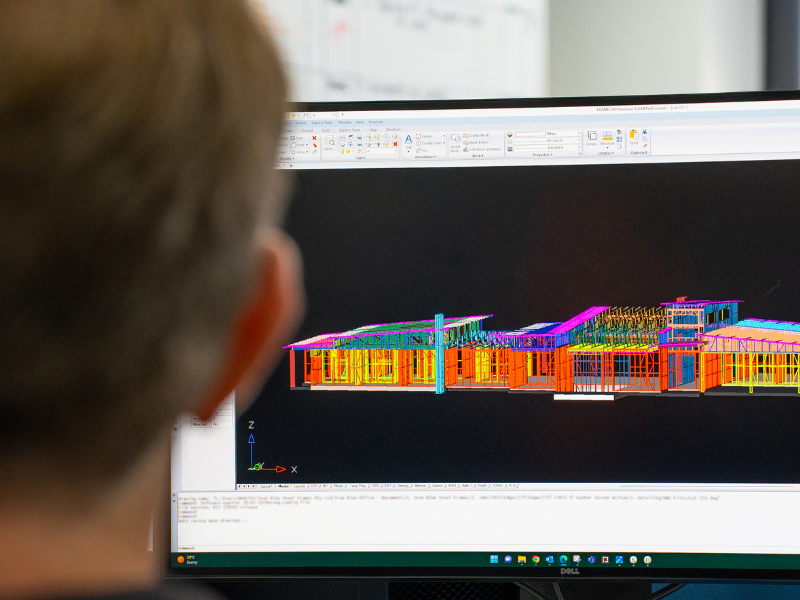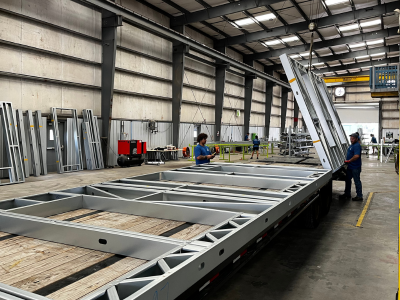Why Developers are Moving from Traditional Design to DfMA for Cold Formed Steel Framing
Using a design-led construction process to improve speed, cost and performance.
For decades, traditional construction has followed a predictable pattern - architects design, engineers refine and builders figure out how to make it work on site. While this process has delivered countless successful projects, it’s become a struggle to meet modern demands for speed, cost certainty and sustainability.

Enter Design for Manufacture and Assembly (DfMA), a methodology that’s gaining traction among developers seeking a more controlled, predictable and efficient way to deliver buildings.
From Onsite Complexity to Offsite Control
Traditional design methods are affected by on-site coordination, access to skilled labor and variable weather conditions. Each project becomes a unique construction challenge, often with unplanned adjustments, re-work, weather delays and inconsistencies caused by the variable nature of organic materials. The result is a familiar mix of cost overruns, increased waste and extended schedules.
By contrast, DfMA begins with the end in mind. It considers how a building will be manufactured and assembled from the earliest design stage. Components are designed for ease of fabrication and assembly, in factory-controlled conditions and for quick and precise installation and assembly on site.
This shift from ‘design and then build’ to ‘design to build’ is what allows the DfMA process to deliver consistent results in less time, with fewer surprises along the way.
The Numbers Behind the Movement
The business case for DfMA is clear. The U.S. construction market that utilizes DfMA principles was valued at $39.55 billion in 2021 and is projected to reach $90.33 billion by 2031, an 8.5% compound annual growth rate.
Similarly, the global prefabricated construction market has grown from $112.4 billion in 2019 to over $153 billion in 2023, much of it driven by the efficiencies of DfMA-based methods and materials such as cold-formed steel framing.
Developers are responding to these numbers because DfMA directly addresses the issues that affect their bottom line: labor shortages, waste, quality control and delivery speed.
Comparing Traditional Design and DfMA
This table reflects the fundamental difference:
| Aspect | Traditional Design | DfMA-Optimized Design |
|---|---|---|
| Design focus | Architectural intent first | Designed for modular while considering DfMA |
| Production | Mostly on-site fabrication | Factory-controlled, automated manufacturing |
| Assembly | Complex, tool-heavy, skill-dependent | Simple, precise, tool-light |
| Labor | High reliance on skilled workers | Moderate to low-skilled labor |
| Speed | Slower, weather-dependent | Much faster, predictable |
| Cost | Higher, with variability and waste | Lower, more consistent optimized material utilization |
By designing out inefficiency, DfMA simplifies the production and assembly of components, enabling developers to achieve faster build times and more reliable cost projections, both critical to financial success and high quality.
 |
 |
Why Developers are Making the Shift
1. Predictable Outcomes
In traditional projects, design changes and coordination issues often arise during construction, resulting in costly redesign and rework. DfMA minimizes uncertainty by resolving design and manufacturing details upfront.
2. Speed to Market
Factory-produced components and modular assemblies can reduce project timelines by 20 - 60%, allowing developers to complete more projects per year and start generating revenue sooner.
3. Cost Control and Efficiency
With automation and reduced on-site labor, DfMA-based projects often achieve 20 - 40% cost savings. Materials like cold-formed steel (CFS) also known as light gauge steel (LGS) ensure minimal waste, typically achieving over 99% utilization.
4. Consistent Quality
Manufacturing in controlled environments allows for repeatable precision, rigorous testing, and quality assurance that are impossible to guarantee on a busy construction site.
5. Sustainability and Safety
Offsite manufacturing reduces site disruption, noise and material waste. The lighter, modular components of DfMA projects also improve safety by lowering physical strain and time spent on site.
The Role of Steel Framing
Light-gauge steel framing (LGSF) or steel framing has become the material of choice for many DfMA projects. It’s dimensionally stable, lightweight and 100% recyclable, making it ideal for precision manufacturing and rapid assembly. When paired with advanced design software and automated roll-forming equipment, LGS enables true ‘design-to-build' integration - where every profile, notch and hole is digitally defined before fabrication even begins.
For developers, this translates into shorter build times, tighter tolerances and higher-quality buildings that perform as designed.
A Shift in Mindset
DfMA isn’t just a process change, it’s a mindset shift. It challenges developers and design teams to think like manufacturers, to view buildings not as one-off projects but as products that can be standardized, improved and replicated with precision to lower costs.
This approach doesn’t limit creativity, it enhances it. By freeing teams from on-site inefficiencies, more time and budget can be spent on design, innovation and occupant experience.
The Future of Design and Delivery
As the construction industry evolves, the divide between design, manufacturing and assembly is disappearing. Developers who embrace DfMA early are positioning themselves for the future, one where data-driven design, factory precision and sustainable efficiency become the norm rather than the exception.
For those still relying on traditional design models, the message is clear - Design for Manufacture and Assembly isn’t a trend, it’s a methodology for how buildings will be delivered.
Want to learn more about how LGS framing can transform your next project? Reach out to industry experts here.








